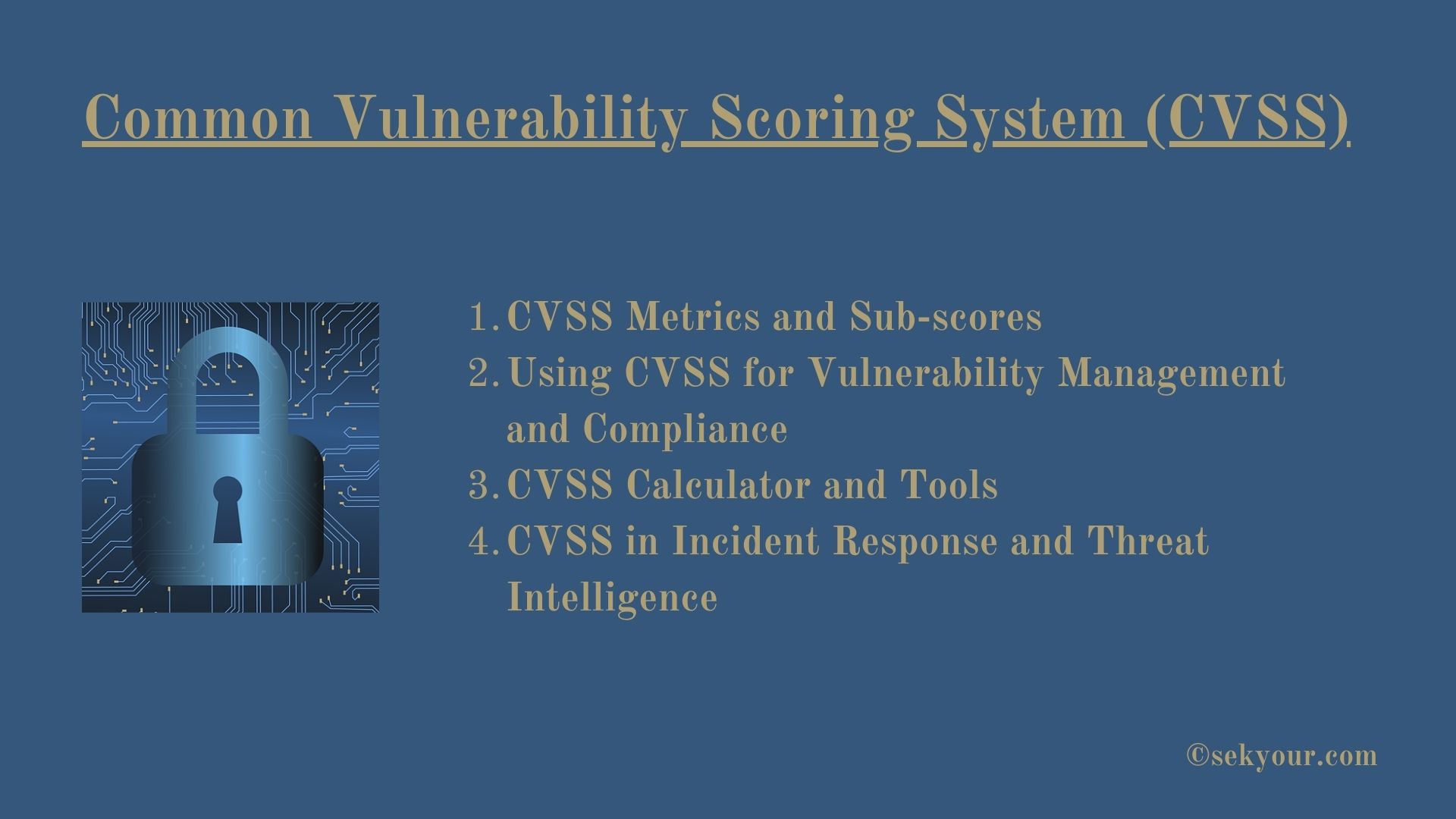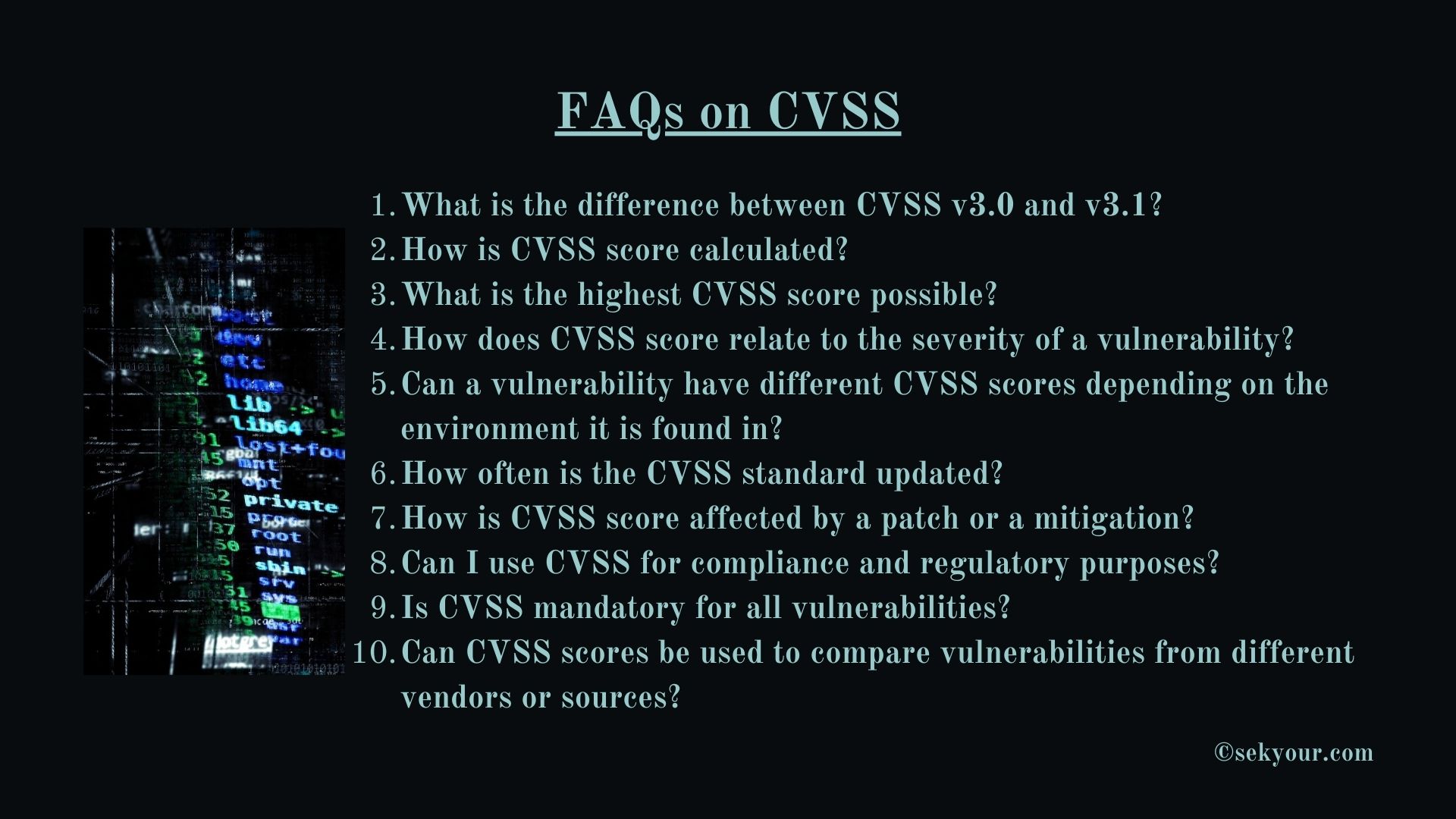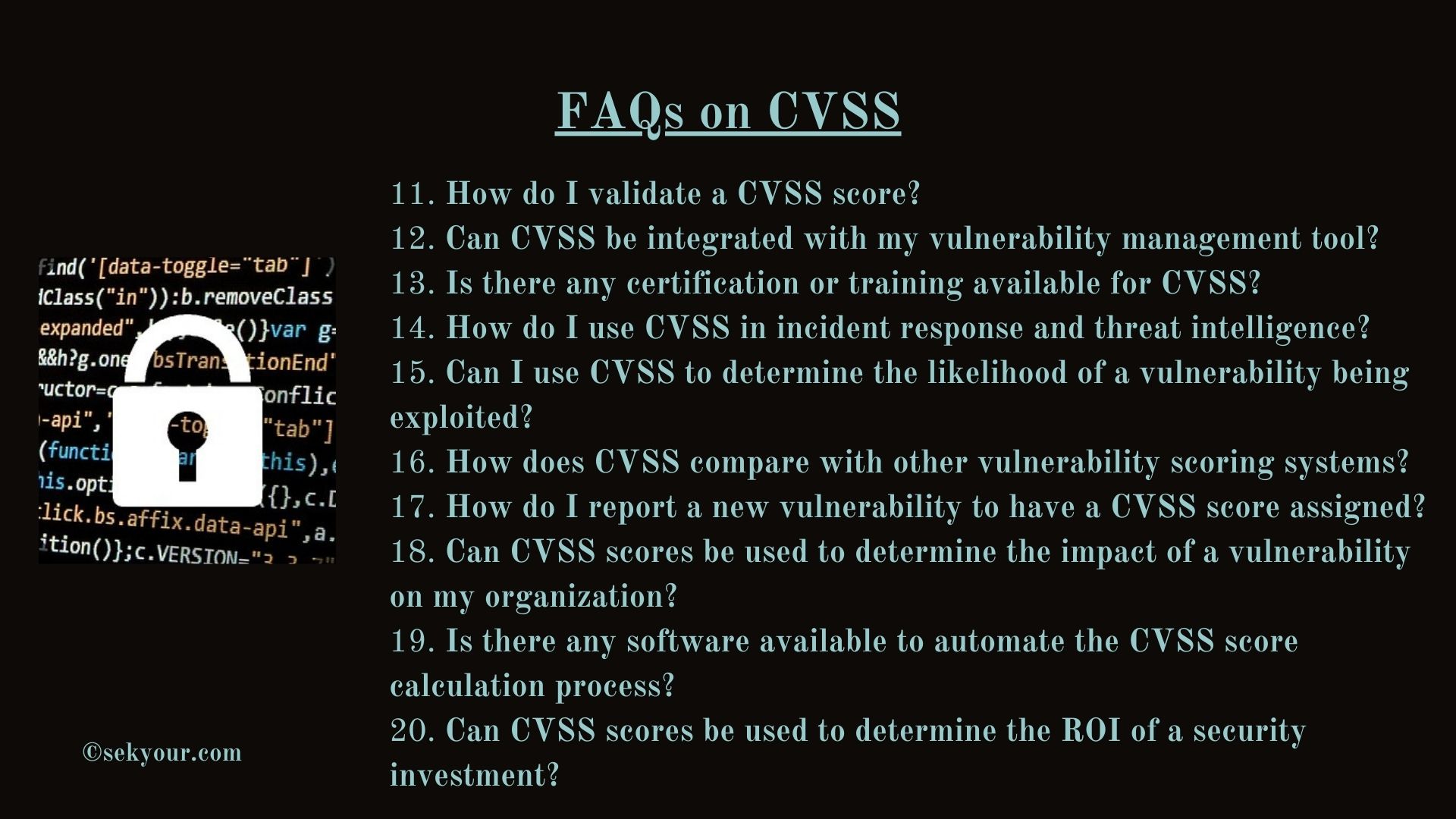1. Introduction
Common Vulnerability Scoring System (CVSS) is a framework for scoring and ranking the severity of software vulnerabilities. It provides a standardized method for assessing the risk associated with a particular vulnerability, which allows organizations to prioritize vulnerabilities and implement effective patch management processes.
CVSS version 3.1 is the current version of the standard and it includes several improvements over previous versions. The standard is made up of three metric groups: Base, Temporal, and Environmental. These metric groups provide data points that are used to calculate a CVSS score, which reflects the overall severity of a vulnerability.
The Base metrics group includes data points that measure the properties of a vulnerability that are constant over time, such as the impact of a vulnerability on confidentiality, integrity, and availability. The Temporal metrics group includes data points that measure the properties of a vulnerability that change over time, such as the number of days since the vulnerability was discovered. The Environmental metrics group includes data points that measure the properties of a vulnerability that are specific to an organization’s environment, such as the number of systems affected.
In CVSS version 3.1, the improvements include new metrics and sub-scores, exploitability and impact, which makes the scoring more accurate and refined. CVSS version 3.1 also includes a new vector string format that makes it easier to communicate the scores and their underlying data. The CVSS standard is widely used in the industry and it’s considered as a reliable way to measure the severity of vulnerabilities.

2. CVSS Metrics and Sub-scores
The CVSS metrics group includes three metric groups: Base, Temporal, and Environmental. Each group provides data points that are used to calculate a CVSS score, which reflects the overall severity of a vulnerability. The Base metrics group includes data points that measure the properties of a vulnerability that are constant over time, such as the impact of a vulnerability on confidentiality, integrity, and availability. The Temporal metrics group includes data points that measure the properties of a vulnerability that change over time, such as the number of days since the vulnerability was discovered. The Environmental metrics group includes data points that measure the properties of a vulnerability that are specific to an organization’s environment, such as the number of systems affected.
Exploitability and Impact sub-scores are additional metrics that have been introduced in CVSS version 3.1, which allows for more accurate and refined scoring. The exploitability sub-score measures the ease with which an attacker can exploit a vulnerability. The impact sub-score measures the potential impact of a successful exploit on the confidentiality, integrity, and availability of the affected systems.
In vulnerability management, CVSS scores are used to prioritize vulnerabilities and determine which ones should be patched first. Real-world examples of how the metrics and sub-scores are used in vulnerability management include identifying and mitigating vulnerabilities with high CVSS scores, or creating reports that filter vulnerabilities based on their CVSS scores.
The CVSS score calculation process is done by taking the data points from the Base, Temporal, and Environmental metric groups, and inputting them into the CVSS scoring formula. The score is then presented as a numerical value between 0 and 10, with higher scores indicating a more severe vulnerability. To interpret the score, it is important to understand the CVSS score ranges and what they represent, for example, a score of 9-10 is considered critical, 7-8.9 is considered high and so on.
3. Using CVSS for Vulnerability Management and Compliance
CVSS can be used to prioritize vulnerabilities and implement effective patch management processes in vulnerability management and mitigation. Best practices for utilizing CVSS in vulnerability management and mitigation include continuously monitoring the list for new vulnerabilities, prioritizing vulnerabilities based on their CVSS scores, and implementing effective patch management processes.
CVSS scores can also be used to comply with industry standards and regulations such as PCI DSS, HIPAA, and NIST, as they provide a standardized method for assessing the risk associated with a particular vulnerability. Organizations can use CVSS scores to identify vulnerabilities that are in scope for compliance and to determine if they have met the requirements for compliance.
CVSS can also be used to identify and mitigate regulatory and compliance risks. For example, organizations can use CVSS scores to identify vulnerabilities that could result in a data breach, and then implement appropriate mitigation strategies to prevent a breach from occurring.
There are several case studies of organizations that have successfully used CVSS in their vulnerability management programs. They demonstrate the effectiveness of this approach in identifying and mitigating vulnerabilities, and in complying with industry standards and regulations. Such case studies can be found online and can be a great source of inspiration for organizations looking to implement a similar approach.
4. CVSS Calculator and Tools
There are various CVSS calculators and tools available for determining CVSS scores. These tools can be used to input data points from the Base, Temporal, and Environmental metric groups and calculate a CVSS score. Some popular calculators include the official CVSS Calculator, the NIST CVSS Calculator, and the FIRST CVSS Calculator.
The benefits of using these tools include the ability to quickly and easily calculate CVSS scores, which can be used to prioritize vulnerabilities and implement effective patch management processes. The limitations of these tools include the need for accurate data input, which can be a time-consuming process, and the fact that the results are only as accurate as the data input.
CVSS can be integrated with security tools and platforms for improved efficiency. For example, by integrating CVSS with a vulnerability management tool, organizations can automate the process of calculating CVSS scores and prioritize vulnerabilities. This can save time and resources and improve the overall efficiency of the vulnerability management process.
CVSS is widely used in the industry, but it’s important to note that there are other scoring systems available as well, such as the Common Weakness Scoring System (CWSS), Common Attack Pattern Enumeration and Classification (CAPEC), and Common Weakness Enumeration (CWE). Each scoring system has its own set of benefits, limitations and use cases, and organizations should evaluate them based on their own needs and use cases.
5. CVSS in Incident Response and Threat Intelligence
CVSS is widely used in incident response and threat intelligence as a means to prioritize vulnerabilities and assess the risk associated with a particular vulnerability. CVSS scores can be used to determine the severity of a vulnerability, which can help incident responders to quickly identify and mitigate the most critical vulnerabilities.
CVSS scores can change over time, as new information becomes available. For example, a vulnerability that was initially considered to be of low severity may be re-evaluated and assigned a higher CVSS score. It is important to validate the CVSS score of a vulnerability when new information becomes available, to ensure that the appropriate mitigation strategies are being implemented.
There are various training and certifications available for CVSS, which can help individuals and organizations to gain a deeper understanding of the standard and how to use it effectively. For example, the SANS Institute offers a CVSS v3.1 Fundamentals course, and the NIST offers a CVSS v3.1 certification.
CVSS plays a significant role in threat intelligence, as it allows organizations to prioritize vulnerabilities based on their risk level, and also allows incident response teams to understand and prioritize the vulnerabilities they are dealing with. CVSS scores are also used in incident response management, as they provide a standardized method for assessing the risk associated with a particular vulnerability.
6. Conclusion
In conclusion, the Common Vulnerability Scoring System (CVSS) is a standardized method for assessing the risk associated with a particular vulnerability. It provides a unique identifier for each vulnerability, allowing for easy identification and tracking. The CVSS score, which is calculated using data from the Base, Temporal and Environmental metric groups, is an important tool for vulnerability management and mitigation. It can be used to prioritize vulnerabilities, implement effective patch management processes and comply with industry standards and regulations.
Effective CVSS-based vulnerability management practices include continuously monitoring the list for new vulnerabilities, prioritizing vulnerabilities based on CVSS scores, implementing effective patch management processes, and integrating CVSS with security tools and platforms.
There are a plethora of additional resources available for readers to learn more about CVSS and vulnerability management, such as white papers, guides, and webinars. These resources can help organizations to gain a deeper understanding of the standard, best practices for utilizing it, and how to use it effectively. Therefore, organizations should consider taking a proactive approach to their vulnerability management and utilize CVSS to make their cybersecurity more robust.
7. FAQs on CVSS

1. What is the difference between CVSS v3.0 and v3.1?
CVSS v3.1 is the latest version of the CVSS standard and it improves over v3.0 by introducing new metrics, including the Modified Attack Vector (MAV) metric, which allows for more accurate scoring of vulnerabilities that require the attacker to have access to specific resources or systems before being able to exploit the vulnerability. Additionally, CVSS v3.1 includes improved scoring for vulnerabilities that can be exploited remotely or locally, and improved scoring for vulnerabilities that are dependent on other vulnerabilities.
2. How is CVSS score calculated?
The CVSS score is calculated using data from three metric groups: Base, Temporal, and Environmental. The Base metric group includes metrics such as Attack Vector, Attack Complexity, and Impact. The Temporal metric group includes metrics such as Exploit Code Maturity and Remediation Level. The Environmental metric group includes metrics such as Confidentiality Impact, Integrity Impact, and Availability Impact. Each metric is assigned a numerical value, and the values are used to calculate the CVSS score.
3. What is the highest CVSS score possible?
The highest CVSS score possible is 10.0. A score of 10.0 indicates that a vulnerability is critical and has the highest possible impact on the affected systems and networks.
4. How does CVSS score relate to the severity of a vulnerability?
The CVSS score is a numeric representation of the severity of a vulnerability. The higher the CVSS score, the more severe the vulnerability is considered to be. A score of 10.0 is considered to be the most severe, while a score of 0.0 is considered to be the least severe.
5. Can a vulnerability have different CVSS scores depending on the environment it is found in?
Yes, a vulnerability can have different CVSS scores depending on the environment it is found in. The Environmental metric group includes metrics such as Confidentiality Impact, Integrity Impact, and Availability Impact, which take into account the specific environment in which the vulnerability is found. This means that a vulnerability that has a low CVSS score in one environment may have a higher score in another environment.
6. How often is the CVSS standard updated?
The CVSS standard is updated periodically by the CVSS Special Interest Group (SIG) in response to feedback from the community and changes in the threat landscape. The latest version of CVSS is version 3.1, which was released in June 2019.
7. How is CVSS score affected by a patch or a mitigation?
CVSS score is affected by the presence of a patch or a mitigation through the “Exploitability” and “Remediation Level” metrics. If a patch or mitigation is available, the “Exploitability” metric will be lower, which will, in turn, lower the overall CVSS score. The “Remediation Level” metric also considers whether a patch or mitigation is available, which can also affect the overall CVSS score.
8. Can I use CVSS for compliance and regulatory purposes?
CVSS can be used as a reference for compliance and regulatory purposes, as it provides a standard method for evaluating the severity of vulnerabilities. However, it is important to note that compliance and regulatory requirements may have their specific requirements that CVSS may not fully cover.
9. Is CVSS mandatory for all vulnerabilities?
CVSS is not mandatory for all vulnerabilities, but it is a widely used and accepted method for evaluating the severity of vulnerabilities. Many organizations, software vendors, and government agencies use CVSS to evaluate vulnerabilities.
10. Can CVSS scores be used to compare vulnerabilities from different vendors or sources?
CVSS scores can be used to compare vulnerabilities from different vendors or sources, as it provides a standard method for evaluating the severity of vulnerabilities. However, it is important to note that CVSS scores are based on a set of fixed metrics and may not consider other factors that could affect the impact of a vulnerability in a specific environment.

11. How do I validate a CVSS score?
A CVSS score can be validated by using the online CVSS calculator provided by the CVSS Special Interest Group (SIG), or by using a CVSS calculator from a vendor. It is also important to review the methodology used to calculate the score, and to ensure that the score is based on the latest version of the CVSS standard.
12. Can CVSS be integrated with my vulnerability management tool?
CVSS can be integrated with vulnerability management tools, as it provides a standard method for evaluating the severity of vulnerabilities. This allows organizations to prioritize vulnerabilities based on their CVSS scores, and to track the progress of remediation efforts.
13. Is there any certification or training available for CVSS?
There is no official certification for CVSS, but training and educational resources are available from the CVSS Special Interest Group (SIG) and other organizations. These resources can help individuals and organizations understand the methodology used to calculate CVSS scores, and how to use CVSS in their vulnerability management processes.
14. How do I use CVSS in incident response and threat intelligence?
CVSS can be used in incident response and threat intelligence by providing a standard method for evaluating the severity of vulnerabilities. This allows organizations to prioritize vulnerabilities based on their CVSS scores, and to track the progress of remediation efforts. Additionally, CVSS scores can be used to evaluate the potential impact of a vulnerability on an organization, and to inform incident response and threat intelligence activities.
15. Can I use CVSS to determine the likelihood of a vulnerability being exploited?
CVSS does not provide information on the likelihood of a vulnerability being exploited. The CVSS score only reflects the potential impact of a vulnerability. Other factors such as exploitability, the presence of known exploits and the ease of weaponizing the vulnerability should be considered to determine the likelihood of a vulnerability being exploited.
16. How does CVSS compare with other vulnerability scoring systems?
CVSS is a widely used and accepted method for evaluating the severity of vulnerabilities, however, other vulnerability scoring systems do exist. Some other scoring systems, such as the Common Vulnerability Scoring System (CVSS) considers additional factors such as ease of exploitability and the presence of known exploits. These additional factors can give a more accurate picture of the risks associated with a vulnerability.
17. How do I report a new vulnerability to have a CVSS score assigned?
To have a CVSS score assigned to a new vulnerability, it should be reported to the organization or vendor responsible for the affected software. They will typically assign a CVSS score based on the information provided in the report, and may also provide additional details such as patches or mitigations.
18. Can CVSS scores be used to determine the impact of a vulnerability on my organization?
CVSS scores can be used to determine the potential impact of a vulnerability on an organization. However, it is important to consider the specific configuration and architecture of the organization’s systems and network when evaluating the impact of a vulnerability.
19. Is there any software available to automate the CVSS score calculation process?
There are a number of software tools available that can automate the process of calculating CVSS scores. These tools typically use the CVSS standard to calculate scores based on the information provided, and can be integrated with vulnerability management tools to automate the process of evaluating vulnerabilities.
20. Can CVSS scores be used to determine the ROI of a security investment?
CVSS scores can be used as a reference when determining the ROI of a security investment. By assigning a CVSS score to a vulnerability, organizations can prioritize vulnerabilities based on their potential impact, and use this information to inform investment decisions. However, it’s important to note that other factors such as the likelihood of a vulnerability being exploited, the effort required to remediate a vulnerability, the cost of a potential breach, and the value of the assets protected by the security investment should also be considered when determining the ROI of a security investment.